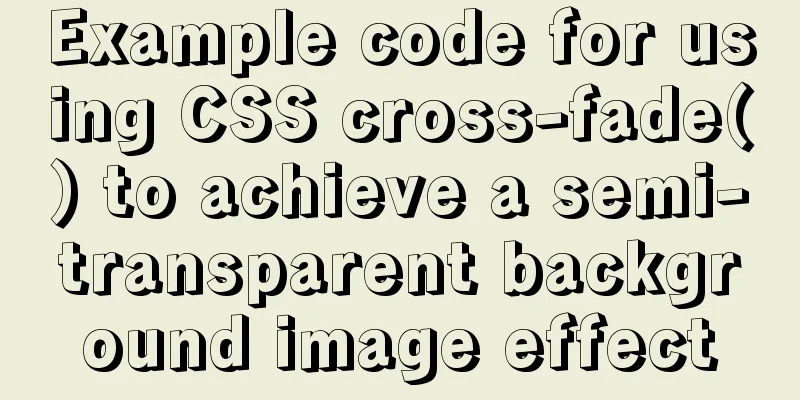Example code for using CSS cross-fade() to achieve a semi-transparent background image effect

|
1. Requirements description
For a certain element, you want the background If it is a solid color background or a CSS gradient background, it is easy to handle. Just use However, if it is If it is an inline I guess many people would think of using the
.box {
position: relative;
z-index: 0;
}
.box::before {
content: '';
position: absolute;
left: 0; right: 0; top: 0; bottom: 0;
background: url(xxx.jpg) no-repeat center / contain;
z-index: -1;
opacity: .5;
}The real-time effect is as follows (if there is no effect, please visit the original author Zhang Xinxu): by-zhangxinxu However, this method is too verbose and costly (it creates a lot of stacking contexts and the size needs to be adjusted), so it cannot be used on a large scale. Is there any good way to implement it? Try using 2. cross-fade() makes the background image semi-transparent For example: <div class="cross-fade-image"></div>
.cross-fade-image {
width: 300px; height: 300px;
background: no-repeat center / contain;
background-image: -webkit-cross-fade(url(1.jpg), url(2.jpg), 50%);
background-image: cross-fade(url(1.jpg), url(2.jpg), 50%);
}The effect will be as shown in the figure below.
Image The above example uses the traditional syntax of <dfn id="ltimage-combination"> <image-combination> </dfn> = cross-fade( <image>, <image>, <percentage> ) Here Regarding the percentage value in The screenshots are as follows:
Although the original intention of The implementation principle is very simple. Use a transparent image for the first image and a target image for the second image. For example: A background image is too bright in dark mode. I want to adjust the brightness of the background image.
.dark {
/* Fallback, IE and Firefox browsers*/
background-image: url(2.jpg);
--transparent: url(data:image/gif;base64,R0lGODlhAQABAIAAAP///wAAACH5BAEAAAAALAAAAAABAAEAAAICRAEAOw==);
/* The latest version of Safari no longer requires a private prefix*/
background-image: cross-fade(var(--transparent), url(2.jpg), 40%);
/* If you use custom properties, the -webkit- statement needs to be placed below the statement without the private prefix*/
background-image: -webkit-cross-fade(var(--transparent), url(2.jpg), 40%);
background-size: cover;
}The effect is as follows:
Isn’t it simple? Isn’t it much more reliable than pseudo-element implementation? The corresponding demo can be found here. Therefore, using 3. Excellent mobile compatibility
Therefore, you can use it with confidence on mobile devices. As for PC, you can use it with confidence if you don’t need to consider the IE browser. Even if you need to consider IE, there is nothing wrong with it. The only difference is that the background image is still completely opaque, and the visual experience is slightly lower. There are no such things as useless CSS properties in this world, it’s just that you haven’t encountered the right scenario; just like those of you who are still single, you just haven’t met the right one yet. In addition, the This concludes this article about using CSS cross-fade() to achieve background image translucent effect with sample code. For more information on CSS cross-fade() background image translucent effect, please search 123WORDPRESS.COM’s previous articles or continue browsing the related articles below. We hope that you will support 123WORDPRESS.COM in the future! |
<<: Disable autocomplete in html so it doesn't show history
>>: Solution to data duplication when using limit+order by in MySql paging
Recommend
Floating menu, can achieve up and down scrolling effect
The code can be further streamlined, but due to t...
MySQL 8.0.12 Simple Installation Tutorial
This article shares the installation tutorial of ...
MySQL data type optimization principles
MySQL supports many data types, and choosing the ...
HTML tag default style arrangement
html, address,blockquote,body, dd, div,dl, dt, fie...
Docker builds the code detection platform SonarQube and detects the process of Maven projects
1 Introduction Good coding habits are qualities t...
Linux directory switching implementation code example
Switching files is a common operation in Linux. W...
VMWare15 installs Mac OS system (graphic tutorial)
Installation Environment WIN10 VMware Workstation...
VMware Workstation 15 Pro Installation Guide (for Beginners)
01. VMware Workstation Pro 15 Download Download: ...
MySQL uses triggers to solve the row limit of the table in the database. Detailed explanation and examples
MySQL uses triggers to solve the row limit of the...
Six important selectors in CSS (remember them in three seconds)
From: https://blog.csdn.net/qq_44761243/article/d...
How to set the border of a web page table
<br />Previously, we learned how to set cell...
Use dockercompose to build springboot-mysql-nginx application
In the previous article, we used Docker to build ...
Mini Programs use Mini Program Cloud to implement WeChat payment functions
Table of contents 1. Open WeChat Pay 1.1 Affiliat...
The complete usage of setup, ref, and reactive in Vue3 combination API
1. Getting started with setUp Briefly introduce t...
What is the difference between HTM and HTML? What is the difference between HTM and HTML?
In the process of learning web design, I did not ...





![MySQL dual-machine hot standby implementation solution [testable]](/upload/images/67cada729f1d5.webp)








